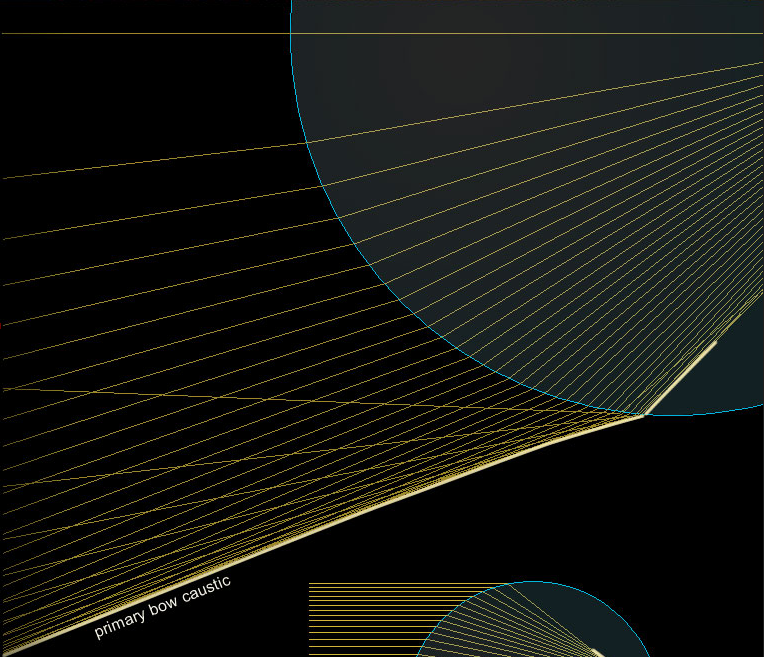OPOD - Caustic Fringes
OPOD - Caustic Fringes: A Phenomenon of Light and Color
Have you ever seen the narrow colored fringes that sometimes appear close inside a primary rainbow? These intriguing bands, known as supernumerary arcs, are a captivating optical phenomenon that can be witnessed under specific conditions. While it is fairly common to observe one fringe, spotting four or five is considered quite rare. In this article, we will explore the mesmerizing world of supernumerary fringes and shed light on the science behind their formation.
Supernumeraries are diffraction effects associated with a light caustic. When raindrops are small and of uniform size, typically 1mm in diameter or less, the conditions become favorable for the appearance of supernumerary arcs. The spacing between these fringes widens as the drop size decreases. Furthermore, raindrops that are uniform in size exhibit a greater number of fringes compared to those with varying sizes. This is because uniform-sized drops experience less blurring caused by the overlap of different fringe spacings.
To understand the formation of supernumeraries, let's delve into the intricate behavior of light within raindrops. When light rays enter a raindrop and reflect once inside, they give rise to the primary rainbow. As these rays emerge from the drop, they fold over and intersect each other, creating a complex pattern. The region where rays intersect and the region where no rays exist form a caustic sheet—a fold caustic—marking the intensely bright rim of the rainbow.
In the vicinity of the caustic sheet, each intersecting pair of rays and waves coalesce and interfere with each other. When wave crests coincide, they produce brightness, whereas out-of-phase crests result in darkness. This interference between waves gives rise to a set of light and dark diffraction fringes that run parallel to the caustic sheet—these are the supernumerary arcs.
The number and intensity of supernumeraries depend on various factors, including the size and uniformity of raindrops, as well as the angle at which sunlight strikes the drops. Under optimal conditions, the primary rainbow may exhibit a vibrant display of multiple supernumerary fringes, creating a truly enchanting sight for those fortunate enough to witness it.
Although supernumeraries are most commonly associated with rainbows, they can also occur in other atmospheric optical phenomena, such as fogbows and cloud bows. In these instances, the presence of tiny water droplets or ice crystals creates the necessary conditions for the formation of these delicate fringes.
Capturing the beauty of supernumerary arcs on camera can be a challenging task. Due to their faint and narrow nature, they may not always be visible to the naked eye or easily captured in photographs. However, with the right equipment and techniques, photographers have managed to document these captivating phenomena, allowing us to appreciate their intricate patterns and ethereal beauty.
In conclusion, supernumerary fringes, also known as caustic fringes, are a remarkable manifestation of diffraction effects associated with light caustics. These narrow colored bands that appear close inside a primary rainbow are a testament to the wondrous interplay between light and water droplets. Whether you're lucky enough to witness them firsthand or marvel at photographs capturing their elusive presence, supernumerary arcs serve as a reminder of the mesmerizing complexity inherent in our atmosphere's optical phenomena.

Rainbow Supernumeraries ~ Captured by Lisa Gonnelli in New Jersey, USA. So many supernumerary fringes inside the primary bow are an unusual sight. ©Lisa Gonnelli, shown with permission.

Supernumerary arcs are the narrow coloured fringes sometimes seen close inside a primary rainbow. To see one fringe is fairly common to see 4-5 is rare.
Supernumeraries are seen when raindrops are small (1mm dia. or less) and of uniform size. The fringe spacing widens with decreasing drop size and uniform sized raindrops show most fringes because there is less blurring from overlap of different fringe spacings.
Supernumeraries are diffraction effects associated with a light caustic.
Light rays reflected once inside a rain drop form the primary rainbow. The once reflected rays emerge in a number of directions and as they do so they fold over and intersect each other.
The surface separating the region of space occupied by two rays intersecting and that where there are no rays is a caustic sheet. The sheet (a fold caustic) marks the intensely bright rainbow rim.
Close to the caustic sheet, each intersecting ray/wave pair coalesces and interferes. Coincident wave crests give brightness, out of phase crests give darkness.
The result is a set of light and dark diffraction fringes parallel to the caustic sheet – The supernumerary arcs.

Note: this article has been automatically converted from the old site and may not appear as intended. You can find the original article here.
Reference Atmospheric Optics
If you use any of the definitions, information, or data presented on Atmospheric Optics, please copy the link or reference below to properly credit us as the reference source. Thank you!
-
<a href="https://atoptics.co.uk/blog/opod-caustic-fringes/">OPOD - Caustic Fringes</a>
-
"OPOD - Caustic Fringes". Atmospheric Optics. Accessed on December 27, 2024. https://atoptics.co.uk/blog/opod-caustic-fringes/.
-
"OPOD - Caustic Fringes". Atmospheric Optics, https://atoptics.co.uk/blog/opod-caustic-fringes/. Accessed 27 December, 2024
-
OPOD - Caustic Fringes. Atmospheric Optics. Retrieved from https://atoptics.co.uk/blog/opod-caustic-fringes/.